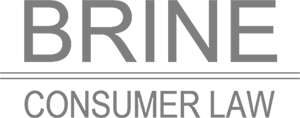
Getting sued by a debt buyer can be scary and intimidating. At Brine Consumer Law, though, we believe that knowledge is power.
Below is a generalized timeline of what happens in a debt collection lawsuit. (Note - this does not apply to cases filed in Small Claims Court).
Debt Collection Lawsuits, Step by Step
Step 1 - Notice of the Lawsuit
You receive notice that the lawsuit has been filed against you. This is typically served by sheriff and left on your front door. It will contain a one page summons and a complaint, which is typically a few pages long. Debt collectors sometimes include other documents (monthly statements, affidavits, etc.) with the complaint, but they are not required to do so.
Step 2 - Respond to the Lawsuit
You have 20 days after receiving notice of the lawsuit to respond, which could be either an answer or a motion to dismiss. An answer should respond to each allegation of the Complaint and either admit or deny the allegation.
Step 3 - Discovery
After an answer is filed, the case proceeds to the discovery phase - in which each party can request documents, answers, and testimony from the other party. These are usually in the form of interrogatories, requests for production of document, and/or requests for admission. Parties can also take depositions, although that is not common in debt collection cases.
Step 4 - Case Management Conference
After an answer is filed, the court will also schedule a case management conference. This is typically a brief status meeting with both parties and the judge. It actually occurs while the Discovery phase is ongoing, but it's listed separately on the list for clarity. The judge will ask about the status of the case, and if there are any discovery disputes between the parties they might be discussed here.
Step 5 - Motion for Summary Judgment
At any point during the case, a party might file a Motion for Summary Judgment, which requests that the court issue a judgment without the need for trial. In order to prevail, the party would have to show that there are no facts in dispute such that they are entitled to win. A debt buyer will typically file this type of a motion seeking to avoid the need for trial.
Step 6 - Pre-Trial Conference
Prior to trial, the parties will have a final court hearing with the judge to review the status of the case and what is expected to occur at trial. The parties are required to file a joint memorandum with the court, explaining the facts in dispute, a list of witnesses, and the expected length of the trial. The court will schedule a trial date at this hearing.
Step 7 - Trial
Finally, the case is ready for trial. The debt buyer has the burden of proof and will be entitled to present its witnesses and evidence, and you will be entitled to present your witnesses and evidence in defense of the case. Trials may be decided either by the judge or by a jury. At the conclusion, a verdict will be issued deciding who wins.
You Have A Legal Issue
As you can see, court procedures are very structured and there are lots of legal requirements on both you and the debt buyer. Some debt buyers have been punished for business practices that prey on only people who don't defend themselves, so that the debt buyers get easy wins without having to do anything. Don't fall victim to this.
If you've recently been served with a debt collection lawsuit, contact Brine Consumer Law today for a free consultation to discuss your options.


